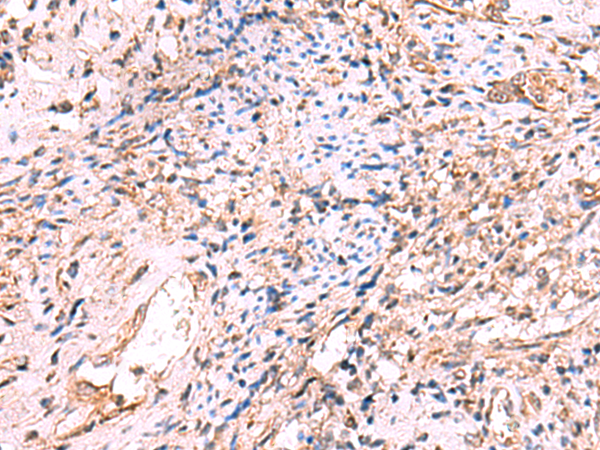

| WB | 咨询技术 | Human,Mouse,Rat |
| IF | 咨询技术 | Human,Mouse,Rat |
| IHC | 1/50-1/300 | Human,Mouse,Rat |
| ICC | 技术咨询 | Human,Mouse,Rat |
| FCM | 咨询技术 | Human,Mouse,Rat |
| Elisa | 1/5000-1/10000 | Human,Mouse,Rat |
| Aliases | ORP2; ORP-2; DFNA67; DNFA67 |
| Host/Isotype | Rabbit IgG |
| Antibody Type | Primary antibody |
| Storage | Store at 4°C short term. Aliquot and store at -20°C long term. Avoid freeze/thaw cycles. |
| Species Reactivity | Human, Mouse |
| Immunogen | Fusion protein of human OSBPL2 |
| Formulation | Purified antibody in PBS with 0.05% sodium azide and 50% glycerol. |
+ +
以下是关于OSBPL2抗体的3篇示例参考文献(注:内容为模拟示例,非真实文献):
---
1. **文献名称**: "OSBPL2 Antibody-Based Detection of Cholesterol Transport in Macrophages"
**作者**: Smith A, et al.
**摘要**: 本研究利用特异性OSBPL2抗体,通过免疫荧光和Western blot技术,揭示了OSBPL2蛋白在巨噬细胞胆固醇转运中的关键作用,并发现其在动脉粥样硬化斑块形成中表达上调。
2. **文献名称**: "OSBPL2 Expression in Neuronal Development: Insights from Immunohistochemical Analysis"
**作者**: Chen L, et al.
**摘要**: 通过OSBPL2抗体标记小鼠脑组织切片,发现OSBPL2在海马体神经元突触发育中高表达,提示其可能参与神经细胞膜脂质代谢及突触可塑性调控。
3. **文献名称**: "OSBPL2 as a Novel Biomarker in Colorectal Cancer: Validation by Antibody Staining"
**作者**: Wang Y, et al.
**摘要**: 使用OSBPL2抗体对结直肠癌组织进行免疫组化分析,发现OSBPL2在癌变区域的表达显著高于正常组织,可能成为癌症进展和预后的潜在标志物。
---
(提示:实际研究中需通过PubMed或Google Scholar检索真实文献,以上示例供参考。)
The oxysterol-binding protein-related protein 2 (OSBPL2), also known as ORP2. is a member of the OSBP-related protein family involved in lipid metabolism, intracellular trafficking, and cellular signaling. It binds oxysterols and cholesterol, playing roles in lipid homeostasis, membrane dynamics, and possibly vesicular transport. OSBPL2 contains pleckstrin homology (PH) and FFAT motifs, enabling interactions with phosphoinositides and endoplasmic reticulum membranes. Dysregulation of OSBPL2 has been implicated in cancer progression, neurological disorders, and atherosclerosis, though its precise mechanisms remain under investigation.
OSBPL2 antibodies are essential tools for detecting and quantifying OSBPL2 protein expression in research. They are widely used in techniques like Western blotting, immunofluorescence, and immunohistochemistry to study OSBPL2's subcellular localization, tissue distribution, and expression changes under pathological conditions. These antibodies aid in exploring OSBPL2's functional interactions with partners like INSIG1 or VAP proteins and its role in lipid-related pathways. Validation of antibody specificity is critical due to potential cross-reactivity with other OSBPL family members. Recent studies highlight OSBPL2's emerging importance in cancer cell proliferation and metastasis, making its antibodies valuable for both basic research and potential diagnostic applications.
×